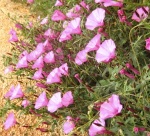As soon as it starts feeling like autumn, I eagerly search for the first wild flowers — daisies, ladies’ tresses orchids, autumn pink scilla, and cyclamen. Searching for their tell-tale buds in the midst of the greening grass, I am careful where I put my feet, lest I crush an emerging treasure. As always, these dainty flowers catch me by surprise — having unfurled their exquisite petals and leaves while I wasn’t looking. I don’t know what I was expecting — did I want to catch them just at the point of their awakening? Perhaps I was. Perhaps I wanted to watch their buds and stems reaching out to the light — dancing in slow motion. Perhaps I would need to set up a time-exposure camera for that. In the meantime, I am more than content to have witnessed yet another year of their miraculous blooming. Welcome to the Mediterranean’s second spring! Shana tovah u metukah!












